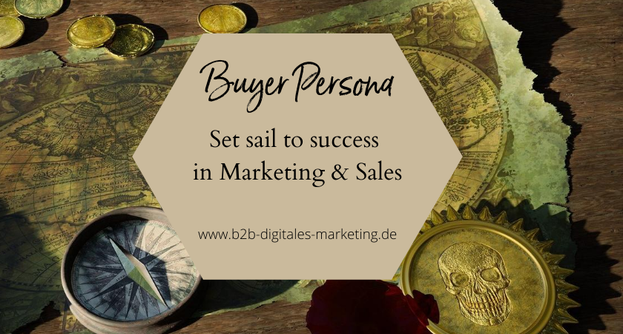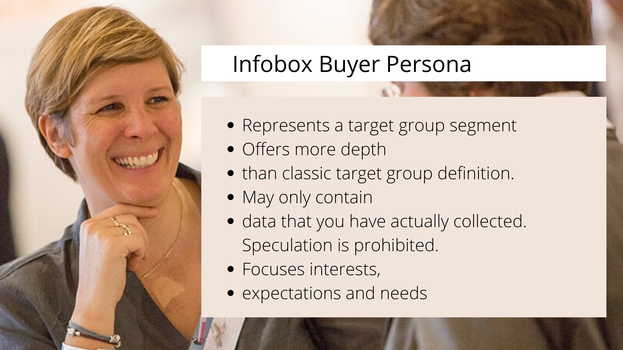Take away:
- Definition Buyer Persona and negative Buyer Persona
- Why the Buyer Persona is an essential part of the strategy
- Buying Center in B2B creates complexity: focus must be
- Most important contents of the Buyer Persona
- Why the in-house knowledge about customers is not enough
- a How-to-Article to creating the Buyer Persona in 7 steps can be found here

What is a Buyer Persona and what do I need it for?
A Buyer or Marketing Persona is in name the ideal person to buy your products or services. Instead of talking about target groups, we are talking about individually approachable people with their own characteristics and problems. In a Buyer Persona, a model-like figure is researched from real-life situations, representing a typical customer. In B2B, the units in the customer company that are involved in the purchase decision are more diverse than in private purchases. That is why we speak of the Buying Center in B2B. Therefore, more Buyer Personas have to be created for a product in B2B than you have to in the consumer goods business. The effort involved is often a deterrent to dealing with the issue. But it is precisely the detailed knowledge of motives, values and problems of your customer contacts that contributes decisively to the success of your sales and online marketing.
The creation of a Buyer Persona - often just called "persona" - must be carried out carefully and realistically. Only if the individual characteristics and motives are realistic and coherent, you will hit the nerve of the desired buyers with your measures. It should be noted that the Buyer Persona is not a company or an organization, but represents a characteristic of people who are involved in the purchase decision. In business customer business, these are not just a few individuals, from the managing director, to purchasing, to the management of the specialist department, to preparatory staff units or similar. This means that a number of Buyer Personas are developed for one of your B2B products, each of which is then addressed differently via marketing content, measures and channels. For example, if the typical staff position is female and more in her 30s, the head of purchasing may be a family man in his prime. Both inform themselves differently and have different personal motives.
The creation of the Buyer Personas sometimes seems complex and the sense is not immediately apparent. "We already know our customers," is a common argument used to avoid the effort of research. But from experience I can say that nothing is more target-oriented in marketing than precise Buyer Personas that you want to address. In return, I promise to show you a pragmatic way to create targeted Buyer Personas with onboard tools.

More is less in the beginning
To avoid getting bogged down, start small. Focus only two or three personas at the beginning. What is your main product/service that you will market in the coming months? Concentrate on this important buying process and conduct a workshop with sales, marketing and specialist departments to identify the two or maximum three people who will ensure a positive buying decision in the target company.
Once you have identified the people involved in the purchase in the customer's buying center, decide who the most important personas are for your buying process. Make painful cuts. Then start to gather important questions from your knowledge base of sales, office staff and specialist departments via the customer contacts:
| Topics | Questions |
| Background Information |
Which profession? Which career path? Married or single? Lifestyle? |
| Demographic Data |
Age, Gender, Income, Origin, regional backgrounds |
| Behaviour |
Wie tritt die Persona auf? Was ist Ihr wichtig? (Zahlen, Daten, Fakten, andere Motive) How does the persona appear? What is important to her? (Numbers, dates, facts, other motives) What are the preferred means of communication? Which communication channels or special media uses the persona to get information on professional matters? |
| Motives |
What are the goals of the persona? (Expressed, implicit, hidden motives?) |
| Pain Points |
What challenges does the persona face at work? What difficulties does it encounter in everyday working life? What puts them under pressure or is currently causing problems? What solutions are being sought that you offer? How can you help the persona to achieve your goals and to create new solutions to existing problems? |
| Quotes | It is lifeley if you have good quotes that the persons expressed in the interview. This helps to see what this persona is all about. Write down concise statements in the text. |
| Current Objections |
What could prevent the personas from responding to your offer? What are possible or expressed objections? |
| Company Culture |
If the company is a small or medium-sized enterprise or a corporation? Is it a corporation or a cooperative? Are there rivalries within the organization? |
| Marketingmessage |
Describe your solution appropriately for each Buyer Persona.. |
| Elevatorpitch |
Say in a few sentences (speakable for the duration of an elevator ride) why the Buyer Persona should buy your solution. |
Field research is mandatory - no speculations
After the workshop in which you have gathered your inhouse knowledge about personas, it is essential that you verify your information outside your own company. Otherwise you will only be cooking in your own juice. This step is often skipped, because after the internal workshop credible slides can already be created with the Buyer Persona. But unfortunately, all of these slides have been created from the inside view by employees of your own company. You cannot be sure of missing something important. Or you do not take sufficient account of new personas that appear on the screen. If, for example, the age structure of your company differs from the typical age structure of your desired customers, you may miss the motives, information channels or pain point of the personas, because this reality has not found a place in your internal round.
At this point of the journey to the buyer persona, marketing agencies like to come into play, which - quite rightly - point out that the best information can only be obtained from an independent third party. And they then sell you expensive interviews that they conduct for you. That quickly costs many thousands of Euros. And if you're just a bit on the ball, you can save yourself that. Take employees from marketing, sales or students who want to write a bachelor thesis with you and have them interview your customers' contact persons. Add potential customers who have not yet bought from you to the respondents.
Make a list of your customer base and search for customer profiles similar to those of your desired customers. Then search the customer database to find the contact persons in the corresponding items in the Buyer Personas. These are then the target persons who ask you for interviews.
Create a list of your customer contacts. You can search for them in the business networks LinkedIn or Xing. Which functional or demographic details can be found here? In which forums are the persons active? What topics are they interested in or what do they post? This research, which can usually be carried out by one person in two days, enables you to add information to the interviews you have conducted and collect a lot of data for the buyer personas.
What is a negative Buyer Persona?
While the buyer persona is a representation of the ideal customer, the negative buyer persona can be used to make it clear what type of person you do not want to have as a customer under any circumstances. These could be people who do not have a need or budget for your products, or who are not suitable as target customers for other reasons.
Further reading suggested: How to create a perfect Buyer Persona in 7 steps

Kommentar schreiben